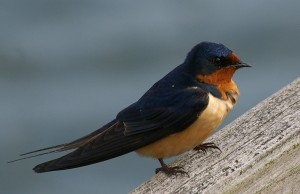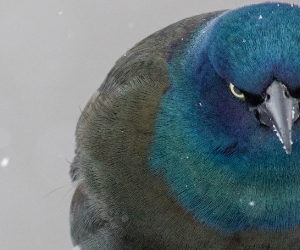Species Spotlight: Barn Swallow
Get to know some of the species at risk in the Lac Deschênes IBA with the Species Spotlight, aka “Sp-Spot”. Today meet the: Barn Swallow

Photo by Jane Kirkland
Scientific Name: Hirundo rustica
SARA Status: No Status; Ontario: Threatened
Taxonomic Group: Birds
Size: An average length of 14.6-19.9 cm, weight of 17-20 g, and wingspan of 31.8-34.3 cm
Characterized by its velvety blue posterior and long forked tail, the barn swallow is one of the most widespread species in the world that can be found on every continent except for Antarctica and Australia. It is a rather small bird which is easily identified by its distinctive flight behaviour in which groups of at least a dozen individuals fly close to the ground in zig-zagging patterns. What may seem like random movements is, however, actually a method developed to efficiently forage for insects and feed without having to stop mid-flight.
As their name implies, these birds commonly nest in various human structures, including on the underside of bridges and of course, in barns. Once a suitable area is chosen and a mate determined, a nest is made.
Where can you see this species?
Barns Swallows chase summer from the northern hemisphere to the southern hemisphere following flying insects, These birds can be found around the world from the Americas to eastern Asia. In the winter, they will migrate to other parts of Asia and South America. No matter where you live, it is likely you will be able to easily glimpse a barn swallow soaring across the ground as they will go foraging for prey, sometimes more than one kilometer away from their nests.
Locally, the Ottawa River is the place to observe this species from May to September. This and other species of swallows feed above the river where insect populations abound. Barn Swallows also are common over pasture lands grazed by livestock.
Did You Know?
• When adults, usually males, are unable to find a mate during breeding season, they will assist another pair in building a nest, incubating the eggs, and rearing the chicks. However, because of the polygamous nature of these birds, these helpers occasionally end up mating with the female at the nest.
• Males with long, symmetrical tails are considered the most attractive to females.
• Since 1960, the barn swallow has been the national bird of Estonia.
• One of the main food items of the Barn Swallow is the mosquito! What a great reason to love this bird!
Check back every week to read about a different species at risk that can be found in Lac Deschênes.
You can report sightings of this and other rare species to the Canadian Wildlife Service at (819) 997-2800 or on the MNR Natural Heritage Information Centre website. A photo and the location of your sighting are also very helpful!
We would like to thank our guest blogger Stephen Lee for contributing this post. Stephen is a student in the IB program and is interested in ecology and sustainability.




